The Windows 10 Review: The Old & New Face of Windows
by Brett Howse on August 25, 2015 8:00 AM EST- Posted in
- Operating Systems
- Microsoft
- Windows 10
DirectX 12 & WDDM 2.0: Reworking the Windows Graphics Stack
At a low-level technical perspective, it’s perhaps a bit of a generalization though none the less true that Windows at the kernel is relatively stable and feature complete these days. After the massive reworking for Windows Vista (6.0), Windows finally reached a point where the kernel and other low-level components of the OS supported the necessary features and sported the required stability to drive Windows for generations to come. As a result Microsoft never significantly tampered with the Windows kernel through Windows 7 (6.1) and Windows 8 (6.2/6.3) – making small feature additions where it made sense to – and even the kernel version number of Windows 10 (10.0) is largely arbitrary, with its roots clearly in 6.x.
Which is not to say that Microsoft hasn’t made low-level changes, only that those changes have been more deliberate and driven by specific needs. Case in point (and getting to the subject matter of this section) is DirectX 12 and its underlying driver structure, the Windows Display Driver Model. Even after the release of Windows Vista and its massive overhaul of the graphics stack, Microsoft has continued modifying the stack over successive generations as GPUs have become more flexible and more capable. After a series of smaller changes in Windows 7 and Windows 8, for Windows 10 Microsoft has gone back to make what are the most fundamental changes to the graphics stack since Windows Vista over 8 years ago.
DirectX 12
Microsoft’s changes ultimately reach out and touch several aspects of the OS, but the bulk of these changes are being put in place to support DirectX 12, the next generation of Microsoft’s game & multimedia API. We have covered DirectX 12 in a great amount of detail over the past year, so for deeper coverage we’ll reference the appropriate articles, but in summary here is what DirectX 12 brings to the table and why it is a big deal.
Excerpt from Microsoft Announces DirectX 12
Why are we seeing so much interest in low level graphics programming on the PC? The short answer is performance, and more specifically what can be gained from returning to it.
Something worth pointing out right away is that low level programming is not new or even all that uncommon. Most high performance console games are written in such a manner, thanks to the fact that consoles are fixed platforms and therefore easily allow this style of programming to be used. By working with hardware at such a low level programmers are able to tease out a great deal of performance of this hardware, which is why console games look and perform as well as they do given the consoles’ underpowered specifications relative to the PC hardware from which they’re derived.
However with PCs the same cannot be said. PCs, being a flexible platform, have long worked off of high level APIs such as Direct3D 11 and OpenGL. Through the powerful abstraction provided by these high level APIs, PCs have been able to support a wide variety of hardware and over a much longer span of time. With low level PC graphics programming having essentially died with DOS and vendor specific APIs, PCs have traded some performance for the convenience and flexibility that abstraction offers.
The nature of that performance tradeoff has shifted over the years though, requiring that it be reevaluated. As we’ve covered in great detail in our look at AMD’s Mantle, these tradeoffs were established at a time when CPUs and GPUs were growing in performance by leaps and bounds year after year. But in the last decade or so that has changed – CPUs are no longer rapidly increasing in performance, especially in the case of single-threaded performance. CPU clockspeeds have reached a point where higher clockspeeds are increasingly power-expensive, and the “low hanging fruit” for improving CPU IPC has long been exhausted. Meanwhile GPUs have roughly continued their incredible pace of growth, owing to the embarrassingly parallel nature of graphics rendering.
The result is that when looking at single threaded CPU performance, GPUs have greatly outstripped CPU performance growth. This in and of itself isn’t necessarily a problem, but it does present a problem when coupled with the high level APIs used for PC graphics. The bulk of the work these APIs do in preparing data for GPUs is single threaded by its very nature, causing the slowdown in CPU performance increases to create a bottleneck. As a result of this gap and its ever-increasing nature, the potential for bottlenecking has similarly increased; the price of abstraction is the CPU performance required to provide it.
3DMark 2011 CPU Time: Direct3D 11 vs. Direct3D 12Low level programming in contrast is more resistant against this type of bottlenecking. There is still the need for a “master” thread and hence the possibility of bottlenecking on that master, but low level programming styles have no need for a CPU-intensive API and runtime to prepare data for GPUs. This makes it much easier to farm out work to multiple CPU cores, protecting against this bottlenecking. To use consoles as an example once again, this is why they are capable of so much with such a (relatively) weak CPU, as they’re better able to utilize their multiple CPU cores than a high level programmed PC can.
The end result of this situation is that it has become time to seriously reevaluate the place of low level graphics programming in the PC space. Game developers and GPU vendors alike want better performance. Meanwhile, though it’s a bit cynical, there’s a very real threat posed by the latest crop of consoles, putting PC gaming in a tight spot where it needs to adapt to keep pace with the consoles. PCs still hold a massive lead in single-threaded CPU performance, but given the limits we’ve discussed earlier, too much bottlenecking can lead to the PC being the slower platform despite the significant hardware advantage. A PC platform that can process fewer draw calls than a $400 game console is a poor outcome for the industry as a whole.
DirectX 12 as a result is the next-generation API that will be providing the basis for graphics going forward in Windows 10. Along with enabling critical improvements in CPU efficiency and scalability in multi-threading, the latest version of Windows’ major graphics API also introduces some other features that further the state of computer graphics. This includes a number of disparate but otherwise “neat” graphics tricks like asynchronous shading to better utilize GPU resources by processing certain classes of rendering tasks in parallel, and explicit multi-adapter functionality that allows the integrated GPUs found on most gaming platforms to be utilized in a meaningful way to contribute to the rendering process, rather than sitting idle as is now the case.
Meanwhile DirectX 12 also introduces some new graphics features that are being rolled out under the feature level 12_0 and 12_1 specifications. These include conservative rasterization for better calculation of pixel coverage, raster order views for better control over rendering order, and even freer resource binding to expand the amount of resources devs can use and how they organize them. And due to the nature of feature levels, most of these benefits are also being exposed in one form or another to the existing DirectX 11 API through DirectX 11.3, though certainly the bulk of their use will be under DirectX 12.
The first commercial DirectX 12 games are expected at the end of this year, with more to follow in 2016. Like so many other elements of Windows 10, ideally Microsoft would like to quickly push development towards this new API, using the free upgrade to quickly build up an established base. With DirectX 11 having taken years to really achieve traction due to the stubborn perseverance of Windows XP, there is a good deal of hope that with the free upgrade there will not be a repeat performance with respect to DirectX 12.
WDDM 2.0
Meanwhile below the API layer, quite a bit of work has gone into Windows at the driver level in order to enable the functionality of DirectX 12. While the full list of these changes are beyond the scope of a simple OS review, perhaps the most important point to take away is that due to these changes, Windows 10 is the biggest overhaul of the Windows graphics stack since WDDM 1.0 in Windows Vista. A big part of this is changes to how virtual memory works, which though largely abstracted from both the user and the developer, is crucial to the performance improvements unlocked by DirectX 12.
However because of these changes, there is a clear division in capabilities between Windows 10 and earlier version of Windows, and for that matter in the drivers for the two OSes. While Windows Vista/7/8 graphics drivers were distributed using a unified WDDM 1.x driver, Windows 10 graphics drivers are being distributed separately as their own WDDM 2.0 build. So much of WDDM 2.0 will be hidden from end users, but this will be one area where though minor, users will notice that something is different.
Memory optimizations and drivers aside, WDDM 2.0 also gave Microsoft the chance to fix some niggling issues in how the graphics stack worked. Quite a bit of effort has been put into multi-display cloning, for example – a feature that never worked quite as well as it should have – with the new WDDM 2.0 stack changing how scaling was being handled so that it’s more useful, more consistent, and works with multiple GPUs. These enhancements are also being deployed to Miracast support, and further improvements are being unlocked there such as support for dynamic resolutions and framerates.
WDDM 2.0 improvements are also an element in enabling Microsoft’s GameDVR feature, which sees game footage recording become an OS-level feature. And for better or worse, WDDM 2.0 also enables some new DRM functionality, which is being deployed as a condition of getting 4K (and above) protected content licensed for use on Windows.


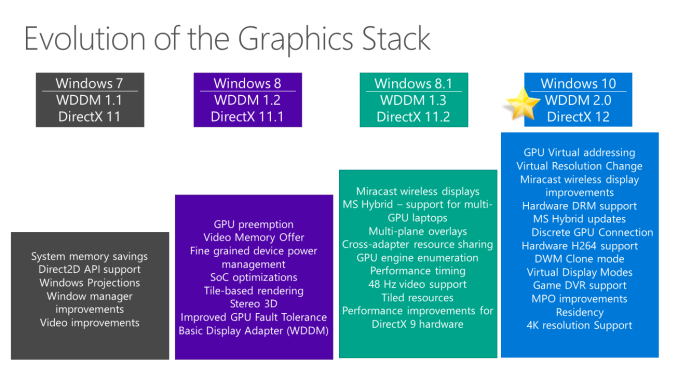
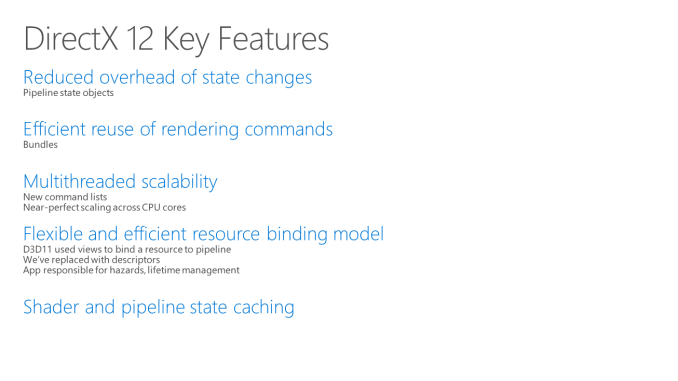

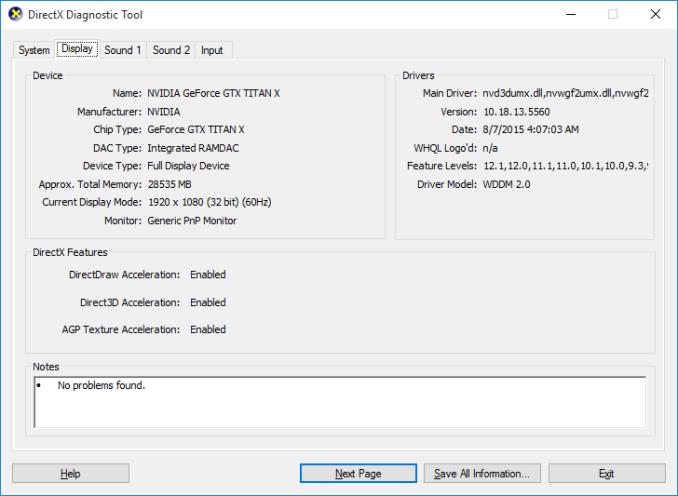

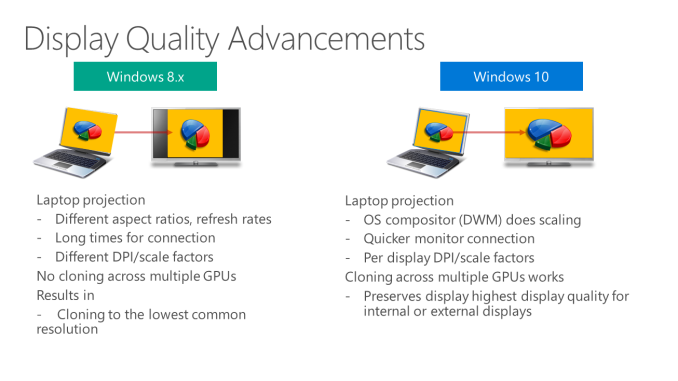
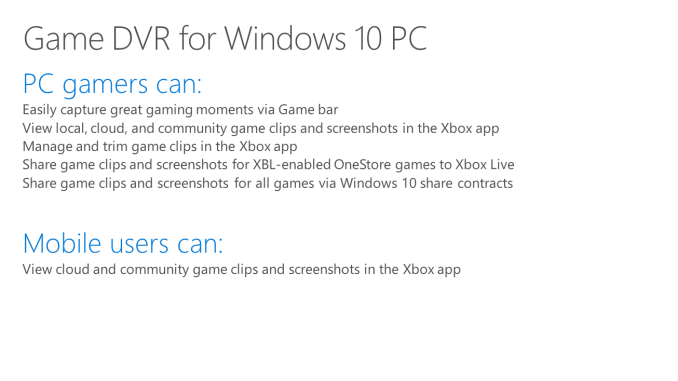








293 Comments
View All Comments
Brett Howse - Wednesday, August 26, 2015 - link
Page 4 on Continuum. Overall it's a slight step back on touch.marvdmartian - Wednesday, August 26, 2015 - link
[from the last page of the article] "But is this going to be the upgrade to move people off of Windows 7? In my opinion, yes it is."Perhaps in your world. Not so much, in mine. Nor, in many people I've talked to, who are equally unimpressed with this latest version of Windows.
In fact, so far, what I've seen (though, I admit, not yet experienced) of W10, I'd label it more of a Windows 8.2.....maybe 8.25. Still blocky looking. Still looks like the icons were drawn by a 3rd grader (no offense to the average 8 year old). Still.....just plain UGLY.
I understand the reasoning for the postage stamp sized blocks, as it makes touch interface much easier. But if they want TRUE switch-ability between touch interface and mouse/keyboard usage, they need to change the look of things, to go with the 2nd choice. Then there's also the return to the 90's screen resolution. Necessary for touch interface, perhaps. But when a person has spent hundreds of dollars on a high resolution monitor, then "upgrades" to Windows 10 (8.25?), they do NOT want to have to dial back their resolution to that which was supported first by what? Windows 98??
And don't even get me started in on the privacy issues. Yes, some people might not have a problem with the information Microsoft is gathering. But I'm betting plenty more will, once they're made aware of it. And for MS to force you to opt OUT of information gathering, makes them somewhat "big brother"-ish, in my book.
Sorry, Brett, but in my book, Microsoft is quickly striking out with this operating system. As far as their support of Windows 7, don't be surprised if they don't extend it, just as they did with Windows XP, if the majority of 7 users don't bother upgrading to 10.
chrome_slinky - Wednesday, August 26, 2015 - link
Unfortunately, for people who think, we must realize that the average user IS stupid, and FREE is making them weak in the knees.I will be on Windows 7 until 2020 at least, and carefully removed the "updates" which install more telemetry from my list of updates.
BTW, you could always use the "illudium235 space modulator" to take care of things, couldn't you? <g>
uhuznaa - Wednesday, August 26, 2015 - link
I'm sick of repeating this over and over but you really shouldn't confuse "is not interested in how computers work" with "stupid". I've seen people who are really bright in their fields totally struggling with their computers because they're just not interested in nor care for how these things work.It's like calling you "stupid" because you are not interested in knitting your own sweaters. I bet there are thousands of things you don't care for and are not interested in which others who are not necessarily smarter than you are really good in.
On the other hand not understanding this may be reason enough to call you stupid.
Michael Bay - Wednesday, August 26, 2015 - link
So, it`s you and your two and a half friends. Such tremendous loss for MS, certainly, somewhere in some basement Nadella is crying crocodile tears.Da W - Wednesday, August 26, 2015 - link
I moved from the FRENCH version of windows 7 to the FRENCH version of windows 8 to the FRENCH update of windows 8.1, somehow it installed the ENGLISH version of windows 10.chrome_slinky - Wednesday, August 26, 2015 - link
Zut alors!Billy_Boy - Wednesday, August 26, 2015 - link
The most thorough, well thought out review of ANY product I have read in a long, long time.Bravo!
milkod2001 - Wednesday, August 26, 2015 - link
I gave it a try and got w10 installed on top of my w7. All took about 30 minutes. All applications/games are working which is great. But that got me thinking what is WINDOWS 10?It feels just like windows 7.1 upgrade. New graphic interface, better boot time and slightly faster copy of files. OK lets not forget dx12 and Cortana. It took MS 6 years since release of w7 to put together this massive update and call it w10. Now i get why MS gave it to us for FREE. It just could not dare to charge us for bunch of mediocre updates.
Happy w10 user here :)
azazel1024 - Wednesday, August 26, 2015 - link
Can I just say, if you are coming from Windows 7, Windows 10 is a fairly nice upgrade. If you are coming from Windows 8.1, especially if you have a touch interface, it is a serious reversion in almost every possible way. Most of the apps seems half finished at best. As eluded to in the story, the mail client is about 10 steps back from the one in 8.1. How basic is it to have the ability to change from conversation view? Photos app doesn't support the ability to view images by folder (which can be nice instead of seeing every single one of your pictures spread out by date). Edge can't download some file types, so you have to open them in IE11. If you want to change audio volume, there is no option to do that in the action center (plenty of room for a button for it). So for a tablet, you have to pull up the task bar to do it, which doesn't make sense. Want to change a wifi network? Oh, there is a button in the action center to do...oh, it only turns Wifi on and off...but, wait, there is an airplane mode button also in there to do that. Oh, you can long press on the wifi button, then go in to settings and then select a different wifi network. Want to change the brightness to anything other than 25/50/75/100%, long press again and go in to settings and then you can adjust it from 0-100% in 1% increments. But...why can't there at least be a 0% brightness on that short cut button? 25% is too bright in a dark room. WHY!Sooooooo much of Windows 10 from what I have seen is "why in the hell would you do it that way?" Sure, some stuff in 8.1 was non-intuitive and took awhile to get used to, but a lot of stuff was a quick gesture and done. Want to change the brightness or audio? Swipe in the charms bar, hit the button and adjust away. Now they are found in different places and one of them takes several extra actions to really be able to adjust where you want it. Many of the apps have lost functionality, even if they look a little nicer or have a few new and nice features. I love that Edge is faster, but it sucks for touch input now and a lot of features have been lost that were highly useful, even with keyboard and mouse input.
Windows 10 at best feels half finished as an operating system. I don't mean "they'll innovate the 'OS as a Service that is Windows 10'". I mean, they needed to have spent at least a few more months baking this thing before sending it out the door and if a lot of this stuff isn't "changed" or give the user the ability to customize (why not add more options that you can add to the action center? What about allowing the user to ELIMINATE options in the action center too, I don't need half the crap that is in there as a short cut) then frankly Win 10 is a big step backward in a lot of ways.
I am willing to give it a try for awhile, but I am itching every single day to reload Windows 8.1 on my Asus T100. I am certainly not going to load Windows 10 on any of my other machines for a very long time to come (either right before the 1 year upgrade period ends, or possibly never).